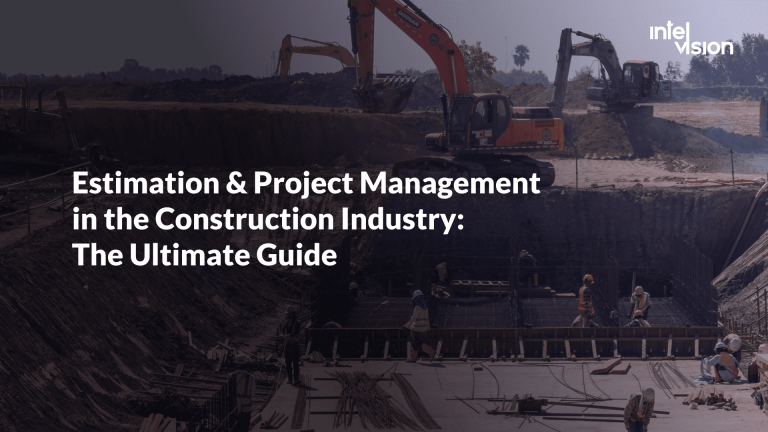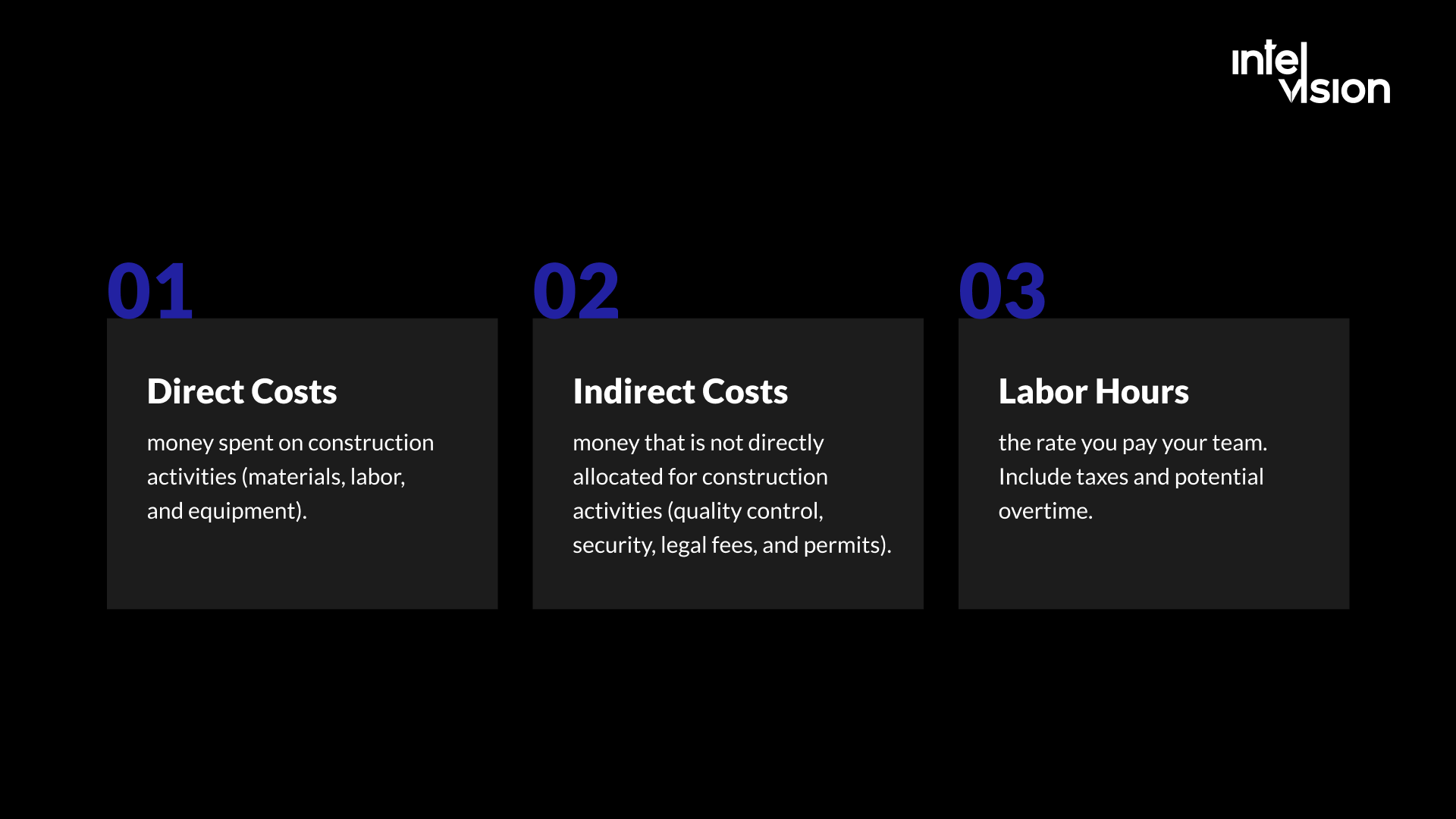
Estimation & Project Management in the Construction Industry
According to Autodesk & Dodge Data & Analytics, about 68% of trades point to poor schedule management as the key contributors to decreased labor productivity. Other issues most commonly faced by business owners and managers are bad project estimation and rework. At the same time, rework has become an expensive standard—$7.1 million in avoidable rework is directly caused by bad data and poor project estimation.
How can you make sure that the money you ask for at the beginning will be enough till the end? And how to measure the bid-to-win ratio, how much a project is over budget or schedule as well as to avoid the state when deadlines are already overdue, the whole project is on fire, and investors are unhappy with the result? We’ve laid out all the cards on the table and compiled top tips on how to manage projects effectively with construction project management software.
What Is Estimating and Costing in Civil Engineering
Construction estimating is the process of assessing all the costs of a project including direct and indirect costs, overhead costs, and a profit margin for the general contractor. A construction estimate is one of the most important steps taken at the early stages of any construction project management process.
Each person and organization might have a different method for making estimation, but most will include these components:
- Direct Costs: money spent on construction activities (materials, labor, and equipment).
- Indirect Costs: money that is not directly allocated for construction activities (quality control, security, legal fees, and permits).
- Labor Hours: the rate you pay your team. Include taxes and potential overtime.
With Intelvision’s construction software development services, you can manage your costs efficiently: from the planning stage, all the way through to the successful completion of each construction project that you undertake.
What Is Construction Project Management
Construction project management involves directing and organizing each part of the project life cycle, from ideation to completion. It’s a holistic practice to deliver projects on time and under budget. Construction project management requires cost control, scheduling, procurement, and risk assessment.
Construction managers have played an important role since the rise of complex building projects. During the Renaissance, individual architects began to be known for their designs, like Sir Christopher Wren of England. Wren designed and built buildings in the late 17th and early 18th centuries, including the masterpiece St. Paul’s Cathedral. Wren had a breadth of knowledge that would foreshadow the types of skills needed on a complicated construction project, with expertise in advanced mathematics, physics, and design. He was on his building sites every day observing every phase of the work.
The rules of project management began to take shape in the US around the time of World War II. By the 1950s, they already were guiding civil construction projects. Today, more and more details of managing a construction project can be done digitally. Software such as a construction cost calculator, and task/time tracker is set to play a major role in the field, as a younger workforce is more comfortable with the technology, and it’ll allow the work to be managed and tracked from anywhere.
Key Construction Planning and Management Challenges
Construction project management involves its share of challenges. Despite the complexity of projects in the industry, companies face typical mistakes using the same project management methods as competitors do. As a result, they often fail or spend more money than planned, and also do not have time to complete the project in the estimated time frame. Here are some of the most common challenges in the construction industry, and some tips on how to overcome them.
Communication & Document Management
If communication isn’t set up, the project manager is waiting for the results of negotiations two weeks ago from another manager, and the customer doesn’t make changes to the project at this time, because they simply did not reach him.
During the planning stage, work out communications with project stakeholders, so all participants will clearly understand what the right information, the right time, and the right person are. It’s also easy to avoid the challenges of attempting to manage communication through email, chat, phone, and other channels with a software solution that centralizes information and communication in a single platform. Together with facilitating frequent communication, contractors, insurance companies, owners, and other parties need a single source of truth they can rely on.
Cost Estimating
Even a minor error in estimation can lead to a loss on a project given the tight margins in the construction industry. A significant margin of error when estimating the cost of a large-scale project could even lead to the project being shut down midway, with a huge amount of sunk costs. The good news is that there are forecasting tools that’ll help you make your estimates as accurate as possible.
Lack of Real-Time Data for Risk Assessment & Change Management
By their nature, construction projects are works-in-progress. This is why you need real-time data to stay on top of new developments and address challenges. The right software solution is the answer. The digital product you choose should make diving into the data easy with up-to-date dashboards and reports while providing the tools you need to visualize workflows and see the impact of your decisions.
How Custom Construction Project Planning and Scheduling Solutions Helps with Construction Estimating & Project Management
According to the SoftwareConnect, construction businesses are looking for the following features the most in construction management solutions:
- project tracking (73%);
- job costing (72%);
- project estimating (66%);
- improved accuracy (47%);
- process standardization or automation (39%).
Plan and collaborate across teams and work styles—try custom estimation and project management software developed by Intelvision’s specialists! We have over 4 years of experience helping multinational clients manage their resources efficiently and effectively. We’ve helped 40+ clients meet their business goals by creating software that helps with construction estimates, planning, scheduling, monitoring, and tracking their performance to make sure they keep to that budget. Our top-notch solutions may contain features such as:
Robust Gantt Charts for Planning
With the Gantt chart, you’ll be able to compare your planned budget with what you are spending as you execute the plan. You’ll know if you are spending too much and can make adjustments before it’s too late.
In-Depth Dashboards to Track Progress
Our custom tool will allow you to track the costs related to your labor and equipment. You can get visibility into how much is being spent with a real-time dashboard that tracks costs in an easy-to-read chart. The cloud-based software gets real-time data and automatically calculates the costs to keep you from going over budget.
Team’s Resources Management
Intelvision’s resource management tools will let you balance the workload of your crew to make sure that tasks are evenly distributed, which boosts productivity. Also, easily see their availability, skill sets, and cost to make better assignments.
Deliver your projects on time and under budget. Start estimating, planning, and managing your projects with Intelvision! Ready to start? Let’s discuss your project and find the right solution that will meet your business goals!
Additional Tips from the CTO and the Intelvision Team: How Not to Fail Project Management
Your project is only as good as how well you execute it. In theory, it may seem brilliant, but when it comes to practice, it fails. How to start projects that will skyrocket? Jacques Pijl, a business consultant and the Managing Director of Turner consulting agency, talks about it in the bestseller “Strategy = Execution: Faster Improvement, Renewal, and Innovation in the New Economy”.
Jacques Pijl has over 20 years of experience in advising company directors and teams of leading organizations on strategy execution and innovation. In addition, he participates in large-scale transformations and surgical precision operations in the private, public and semi-public sectors. His books received bestselling status in the Netherlands and Strategy = Execution was shortlisted for Management Book of the Year and named the CEO’s book of choice by the Dutch Financial Times.
We’ve prepared the most useful principles and supplemented them with the advice of the company’s team.
Set Clear Goals and Criteria for the Project Success
As Lucius Annaeus Seneca said: “If one does not know to which port one is sailing, no wind is favorable.” If we don’t understand the goal of the project and don’t know what result to consider as its achievement, then we solve many problems without getting closer to the goal. At the beginning of the journey, make sure that the customer and the team have the same understanding of the goal, and that everyone understands how to evaluate the completed construction project. Clearly state the criteria for success. Keep in mind they’re different for every project.
Build the Internal Project Processes
Once processes are in place, the team follows role instructions and procedures. It just doesn’t happen as often as business owners or managers would like. To achieve coherence, define the key rules for working on the construction project:
- how communication is organized;
- what to do if a problem occurs or risk is triggered;
- how to deal with changes.
Discuss these rules within the team at the kickoff meeting so that all participants will feel more confident. When the process is clear, tasks are solved easier and faster. This is how our brain works: it needs a plan of action so as not to panic. The simpler and clearer the rules and processes, the more successful the project is.
Get Ready for the Constant Change
To do this, tune in to quick solutions. The team should strive to move to test ideas as soon as possible. A good example is when Unilever management moved production from one factory in Asia to another in two days. Then all halal products had to be reoriented to a new enterprise that didn’t have the appropriate certification. The company made all decisions in two days and implemented the project.
Also, create temporary teams to address critical issues. Since 2015, the Dutch ING Bank has been creating self-managed teams for ambitious tasks. They include employees from all interested departments, and they solve the problem in a short time. Everyone returns to their usual teams after the tasks are completed.
Encourage Team Collaboration
Communications experts in the US have calculated that employee loyalty and satisfaction are 90% related to the quality of internal communications in the company. And The Society of Human Resource Management found that American businesses with 100 employees lose $420.000 annually due to poor communications and team collaboration culture. In companies with 100 thousand employees, this number is about $62.4 million per year.
Add a point of exchange of information between departments in each stage of business planning. So cross-functional communications and cooperation will become the new normal. Also, communicate at least twice a week to determine which communication channels are having problems.
For more tips on effective team and project management, keep an eye on our blog on the website. Every week we publish new articles in collaboration with the CEO, CTO, software developers, and digital marketers of the company that will help take your business to the next level.












![$portfolio_img_mobile['title'] $portfolio_img_mobile['alt']](https://intelvision.pro/wp-content/uploads/2021/03/Group-892-262x350.png)









